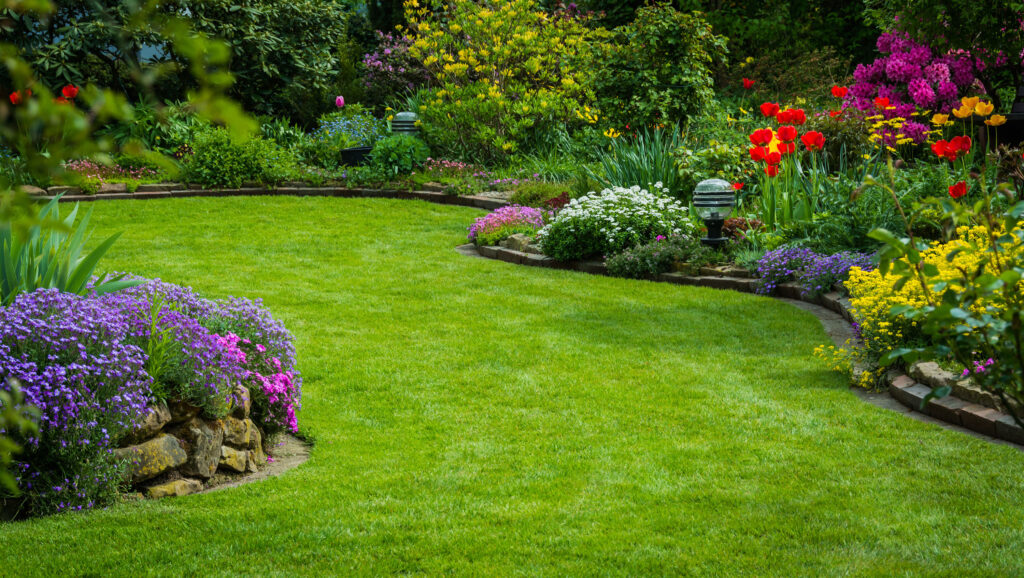As the green heart of your property, a well-maintained lawn can dramatically boost its curb appeal and make your home more inviting. Every season brings its own challenges and opportunities for lawn care. So we’ve compiled a definitive guide that navigates the vagaries of British weather to keep your lawn in tip-top shape all year round.

Bask in the Summer Sun: Summer Lawn Care
The summer season, whilst it provides plenty of sunshine and warmth, can be tough on your lawn. However, with a few proactive measures, your lawn can remain healthy and vibrant throughout.
Watering: During prolonged dry spells, water your lawn thoroughly, ideally in the early morning or late evening when evaporation is minimal.
Mowing: Regular mowing is crucial. A good rule of thumb is to trim the top third of grass blades to encourage healthy growth and keep the lawn dense. Keep mower blades sharp to prevent damaging the grass.
Feeding: Depending on the lawn’s condition, a summer feed may be beneficial. Opt for a high-potassium feed to boost drought resistance and disease resilience.
Dealing with Wear and Tear: Encourage family members and visitors to alternate their path across the lawn to reduce wear and tear.
Fall into Autumn: Autumn Lawn Care
Autumn is a transitional season – a time to start preparing your lawn for the harsh winter months.
Raking: Regularly rake up fallen leaves and debris to prevent suffocation of grass and to discourage diseases.
Scarification: Autumn is the perfect time for scarification, i.e., the removal of thatch (dead grass and moss). This allows the lawn to breathe and promotes the growth of new grass.
Aeration: Aerate your lawn to alleviate soil compaction and improve water, air, and nutrient penetration.
Top-dressing: Top-dressing your lawn improves the soil structure and helps in controlling thatch.
A Winter’s Tale: Winter Lawn Care
Winter might seem like a quiet time for lawns, but don’t be fooled. It requires careful attention.
Keep off the Grass: Minimise foot traffic on the lawn, especially when it’s frosty or waterlogged, to prevent damage.
Watch for Diseases and Pests: Keep an eye out for snow mould and leatherjackets. Seek advice from a professional or a gardening centre if necessary.
Spring into Action: Spring Lawn Care
After the dormancy of winter, spring is a time of rebirth and rejuvenation for your lawn.
Mowing: Start mowing but be sure to keep the blades high for the first few cuts. Gradually lower the cutting height as the season progresses.
Feeding: A spring lawn feed can help in boosting the lawn’s health. Use a high-nitrogen feed to promote leafy growth.
Over-seeding: Areas that have become sparse over the winter could benefit from over-seeding.
Weed Control: Regularly check for and promptly remove weeds. Consider a selective weed killer if necessary.
Scarification and Aeration: Both of these are excellent practices to continue in the spring, as they promote vigorous growth.
Environmental Considerations: Towards an Eco-friendly Lawn
Amidst the various seasonal lawn care activities, it’s essential to remain aware of the impact we have on our environment. Here are a few tips to ensure your lawn care practices are as eco-friendly as possible:
Watering: To conserve water, especially during the warmer months, consider collecting rainwater. This can be easily done using a water butt connected to a downpipe.
Organic Feeds: Instead of synthetic fertilisers, opt for organic lawn feeds. They are kinder to the environment and can often provide a broader range of nutrients.
Natural Pest Control: Consider using natural remedies or biological control for managing pests and diseases, instead of resorting to chemical treatments.
Lawn Alternatives: Thinking Outside the Box
As per the RHS, it may be worth considering lawn alternatives if the condition of your lawn is particularly challenging or if you’re seeking a lower maintenance solution. Some examples include clover lawns, which are more resistant to drought and require less mowing, or a wildflower meadow, providing a feast for the eyes and a haven for local wildlife.
Embrace Your Lawn’s Natural Beauty
Finally, remember to embrace the natural characteristics of your lawn. Lawns don’t have to be pristine and golf-course green to be beautiful. Each lawn is unique, with its mix of grasses, its undulations and even its ‘weeds’, which can be attractive and beneficial to wildlife. Embracing these natural features can bring its own kind of charm to your property.
In the world of property sales and letting, first impressions count, and a well-tended lawn is a key part of that. Lawn care might require a bit of time and effort, but the rewards are well worth it. A well-maintained lawn not only adds to the aesthetics of your property but also contributes to the overall health and biodiversity of your garden. If you need further advice, the Royal Horticultural Society offers a wealth of resources to guide you in your lawn care journey.






